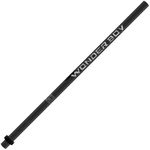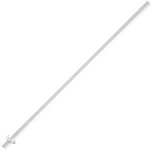Buying Guide for the Best Lacrosse Shafts
Choosing the right lacrosse shaft is crucial for your performance on the field. The shaft, or handle, is the part of the lacrosse stick that you grip and control. It can significantly affect your game, from your shooting accuracy to your defensive maneuvers. When selecting a lacrosse shaft, consider factors such as material, weight, shape, length, and grip. Each of these specifications can influence your playing style and comfort, so it's important to understand what each one means and how it aligns with your needs and preferences.MaterialThe material of a lacrosse shaft determines its durability, weight, and feel. Common materials include aluminum, titanium, scandium, and composite. Aluminum shafts are lightweight and affordable, making them great for beginners. Titanium shafts are stronger and more durable, suitable for more aggressive play. Scandium shafts offer a balance of strength and weight, ideal for intermediate players. Composite shafts are made from a mix of materials, providing flexibility and strength, and are often preferred in colder weather as they don't get as cold as metal shafts. Choose a material based on your level of play and personal preference for weight and durability.
WeightThe weight of a lacrosse shaft affects your speed and control. Lighter shafts are easier to handle and allow for quicker movements, which is beneficial for offensive players who need to maneuver quickly. Heavier shafts provide more power and are often preferred by defensive players who need to deliver strong checks. Consider your position and playing style when choosing the weight of your shaft. If you prioritize speed and agility, go for a lighter shaft. If you need strength and power, a heavier shaft might be more suitable.
ShapeLacrosse shafts come in various shapes, including octagonal, concave, and teardrop. The shape affects how the shaft feels in your hands and your grip on the stick. Octagonal shafts are the most common and provide a balanced grip. Concave shafts have slightly indented sides, offering a more secure grip, which can be helpful for players who need extra control. Teardrop shafts have a unique shape that can provide a comfortable grip for players with larger hands. Try different shapes to see which one feels the most comfortable and secure in your hands.
LengthThe length of a lacrosse shaft varies depending on the player's position. Attackers and midfielders typically use shorter shafts (around 30 inches) for better maneuverability and control. Defensive players use longer shafts (up to 60 inches) to increase their reach and defensive capabilities. Goalies use shafts that are around 40 inches, providing a balance between reach and control. Choose the length based on your position and playing style. Ensure the shaft length complies with the regulations of your league or organization.
GripThe grip of a lacrosse shaft can affect your control and comfort. Some shafts come with a smooth finish, while others have a textured or rubberized grip. A smooth finish allows for quick hand movements but may be slippery, especially in wet conditions. Textured grips provide better control and are less likely to slip, which can be beneficial in all weather conditions. Rubberized grips offer the best control and comfort but may wear down over time. Consider your preference for grip and the playing conditions you typically encounter when choosing the right grip for your shaft.





















